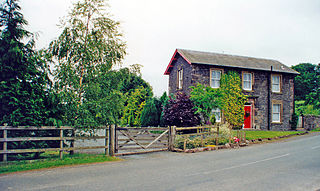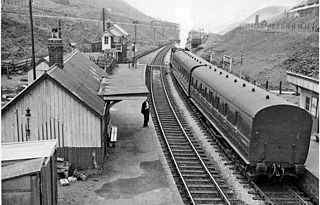The Edinburgh and Glasgow Railway was authorised by Act of Parliament on 4 July 1838. It was opened to passenger traffic on 21 February 1842, between its Glasgow Queen Street railway station and Haymarket railway station in Edinburgh. Construction cost £1,200,000 for 46 miles (74 km). The intermediate stations were at Corstorphine, Gogar, Ratho, Winchburgh, Linlithgow, Polmont, Falkirk, Castlecary, Croy, Kirkintilloch and Bishopbriggs. There was a ticket platform at Cowlairs. The line was extended eastwards from Haymarket to North Bridge in 1846, and a joint station for connection with the North British Railway was opened on what is now Edinburgh Waverley railway station in 1847.
The Edinburgh–Bathgate line is a railway line in East Central Scotland. It is also known as the Bathgate branch and was originally operated by the Edinburgh and Bathgate Railway. Except for the short section at the original Bathgate terminus, the main line is still in use, with a frequent passenger train service operated by ScotRail.
The Slamannan Railway was an early mineral railway between the north-eastern margin of Airdrie and Causewayend on the Union Canal, near Linlithgow, Scotland.
The Wishaw and Coltness Railway was an early Scottish mineral railway. It ran for approximately 11 miles from Chapel Colliery, at Newmains in North Lanarkshire connecting to the Monkland and Kirkintilloch Railway near Whifflet, giving a means of transport for minerals around Newmains to market in Glasgow and Edinburgh.

The Caledonian Railway main line in Scotland connected Glasgow and Edinburgh with Carlisle, via Carstairs and Beattock.
The Glasgow to Aberfoyle Line was a railway line in Scotland, built in stages, leaving the Edinburgh and Glasgow Railway near Lenzie. Tourist traffic was a dominant part of the motivation for building the line, and road tours to the Trossachs from Aberfoyle formed a significant part of the traffic.
Oldham Clegg Street railway station was the Oldham, Ashton-under-Lyne and Guide Bridge Junction Railway station that served the town of Oldham in northwest England, it had three associated goods stations.
The Monkland Railways was a railway company formed in 1848 by the merger of three "coal railways" that had been built to serve coal and iron pits around Airdrie in Central Scotland, and connect them to canals for onward transport of the minerals. The newly formed company had a network stretching from Kirkintilloch to Causewayend, near Linlithgow. These coal railways had had mixed fortunes; the discovery of blackband ironstone and the development of the iron smelting industry around Coatbridge had led to phenomenal success, but hoped-for mineral discoveries in the moorland around Slamannan had been disappointing. The pioneering nature of the railways left them with a legacy of obsolete track and locomotives, and new, more modern, railways were being built around them.
Rainford Village railway station was on the railway line from St Helens to Rainford Junction, then Ormskirk, England.
The Strathspey Railway was a railway company in Scotland that ran from Dufftown (in Moray to Boat of Garten (in Badenoch and Strathspey]], Scotland. It was proposed locally but supported by the larger Great North of Scotland Railway, which wanted to use it as an outlet towards Perth. The GNoSR had to provide much of the funding, and the value of traffic proved to be illusory. The line opened in 1863 to Abernethy, but for the time being was unable to make the desired connection to the southward main line. Although later some through goods traffic developed, the route never achieved its intended purpose.
Thorpe on the Hill railway station was a station serving the village of Thorpe-on-the-Hill, Lincolnshire, England.

Bathgate Upper railway station was a railway station serving the town of Bathgate in West Lothian, Scotland. It was located on the Bathgate and Coatbridge Railway.

Bathgate Lower railway station was a railway station serving the town of Bathgate in West Lothian, Scotland. It was located on the Bathgate Branch of the Monkland Railways.

Fountainhall railway station served the village of Fountainhall, Scottish Borders from 1848 to 1969 on the Waverley Route.

Blaengwynfi railway station served the village of Blaengwynfi, Neath Port Talbot, Wales, from 1890 to 1968 on the Rhondda and Swansea Bay Railway.
The Alyth Railway was a short branch railway line built in Strathmore in Scotland, connecting the town of Alyth to the main line network. It opened in 1861. Its junction was remote from any large population centre except Dundee, which was only reached by a primitive line with three rope worked inclines. This was modernised in 1868 and the Alyth branch, now with a good connection to Dundee, became busy. Nonetheless, the population of Alyth declined, and so did usage of the line, and it closed in 1951.
The Dolphinton Branch refers to two railway branch lines in Lanarkshire and Peeblesshire, Scotland, built in the nineteenth century.

Lowton railway station served the village named Town of Lowton to the east of Newton-le-Willows and south of Golborne.
The Railways of Kinross were a local network of three rural railways which made the town of Kinross in Scotland their objective in the 1850s.

Norton-on-Tees railway station served the town of Norton, County Durham, England from 1877 to 1960, originally on the Port Clarence Branch of the Clarence Railway.







